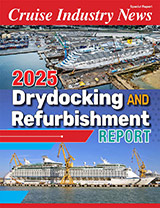P&O Princess Cruises (POC) has reported net income of $18.0 million, or $0.10 per ADS (four shares), on revenues of $542.1 million for the first quarter ended March 31, 2001, compared to net income of $44.7 million, or $0.26 per ADS, on revenues of $519.0 million for the first quarter of 2000.
POC CEO Peter Ratcliffe said in a conference call that the company forecasted a yield reduction of two to three percent for the full year. He said that while bookings for Princess Cruises have remained in line with 2000, pricing continues to be lower year-over year. He said that the company is also seeing increased pricing pressure in Alaska in the third quarter. But Princess has been able to resist the pricing pressure in Europe because of the company’s strong position there and the introduction of the new Golden Princess, Ratcliffe said.
Bookings and pricing in the U.K., Australia and Germany continue to be positive, however, according to Ratcliffe, who said that these markets are not experiencing the pricing pressure the company is seeing in North America.
Ratcliffe said that POC was pursuing its global growth strategy, emphasizing brand differentiation and seeking improved cost efficiencies. So far this year, POC has achieved a two percent cost reduction, in line with the company’s goal to reduce costs 10 percent over five years, according to Ratcliffe. He said that earnings improvements would come from cost reductions in the present economic climate.
Cost reductions are being achieved through the improved economies of scale offered by bigger ships as well as by management actions such as creating a global purchasing department and relocating to less expensive office facilities.
Ratcliffe also pointed out Princess’ strategy in North America of not allowing capacity growth to get ahead of demand. Thus, Princess will withdraw the Pacific Princess from the North American market following her 2002 Bermuda season in addition to the previously announced repositionings of the Crown Princess, Regal Princess and Ocean Princess to European markets.
Princess would not reveal whether the Pacific Princess would be sold or redeployed, however. The sister ship, the Island Princess, was previously sold to Hyundai Cruises.
According to Ratcliffe, the transcanal market has also improved for Princess after the line reduced its canal capacity.
Regarding the Wave Period, Ratcliffe said that Princess has a different booking curve than the other large cruise lines and that the company carries out what he called selective discounting to avoid massive last rninute price changes.
“We have reduced our rate of growth in the U.S. market,” Ratcliffe said, adding that industry-wide he expected to see further ship transfers to global markets.
Looking forward to 2002, Ratcliffe said, “We anticipate that our ships will sail full, the only issue is pricing.
“I am hopeful we will not see yield deterioration in 2002,” Ratcliffe added. He said that industry-wide discounting would be reduced when supply is in line with demand.



